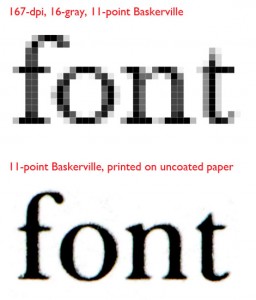My previous blogpost examined some rather esoteric factors regarding e-book reading. Now I’ve come across an article that looks at the legibility of e-book readers in a more scientific way. As someone who pays a lot of attention to typography (I used to do desktop publishing, back when that word was young and exciting) I’ve been annoyed by some of the typography flubs (“smart quotes” anybody?) I’ve found in e-books, but I’m also frustrated by the limited type choices when it comes to formatting e-books. And ever since I started blogging seven years ago, I’ve often wondered which typefaces are more legible for on-screen reading.
The headline is not encouraging:
Whether on Kindle, iPad, Nook, or other LCD display, type suffers compared to print. So is good typography even possible for today’s electronic devices? From the standpoint of the craft’s two underlying principles — legibility and readability — the answer is “no.”
The State of E-book Typography
It turns out that screen type is not rendered very well on an e-reader, regardless of the device. Even the new iPad, with its gazillion pixels, doesn’t give you particularly sharp type.
Look below: Which type would you prefer reading?
(Via)
There’s no question which print looks better at this size, and I bet our eyes know the subtle differences when we read an 11 pt typeset novel as well. And I bet that’s why my eyes get tired, and why I get tired, when I’m reading on my iPad.
As the article points out, technology has improved tremendously for paper printing, yet we’ve taken a huge step backward in legibility when we turn to e-book devices. Ironic, isn’t it?
There are a few things you can do, including increasing text size (at the expense of “real estate”), to make your reading experience less onerous, and several things a publisher can do, including choosing more appropriate typefaces and avoiding justified margins. But other than that, I think we’ll have to wait for manufacturers to catch up to the improvements in print technology. And that may be another hundred years or so, if the pace of improvement matches previous decades.
I don’t see people turning en masse to print books, yet as today’s e-book readers get older and their eyes consequently become less adept at performing the hard work of onscreen reading, I suspect some will be tempted to select non-Kindle versions of their reading material.

